-
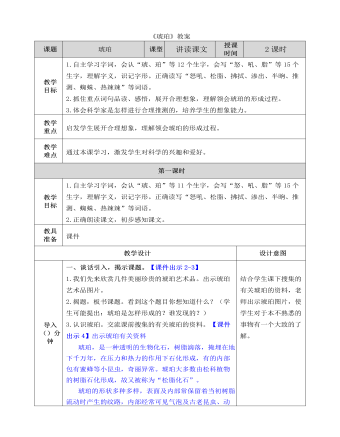
部编人教版四年级下册《琥珀》教案
一、复习检查,导入新课1.检查字词【课件出示20】琥珀松脂拂拭渗出前俯后仰一番澎湃怒吼美餐晌午热辣辣挣扎冲刷推测详细指名读,赛读。1. 这篇课文主要讲了什么故事?预设:课文主要讲了根据一块裹有苍蝇和蜘蛛的琥珀想象这块琥珀形成和发现的过程,并且判断它在科学上的价值。3.谈话导入新课:根据这块罕见的珍贵的琥珀,作者推测想象出一个十分生动的故事,告诉我们琥珀的形成过程。那么,作者是怎样推测、怎样想象的呢?让我们和作者一起思考,一起推测,一起想象。二、品读课文:还原推测过程,品味文章语言。(一)默读课文,大胆质疑。【课件出示21】默读课文,做批注,提出不懂的问题。预设:1.松脂球是怎样形成的?琥珀是怎样形成的?2.它们是怎样成为化石的?3.为什么说“从那块琥珀,我们可以推测发生在几万年前的故事的详细情形?”(二)再读课文,解决问题。

部编人教版四年级下册《芦花鞋》教案
三、联系文本,赏人物之“美”。1.再次默读课文,思考:在卖芦花鞋的过程中,哥哥青铜给你留下的印象是否更深?请在文中相关地方做标记。画出相关语句。【课件出示7、8、9、10】2.小组交流阅读感受。3.全班交流,感悟人物形象。生自读,师巡视。交流相机出示:这是家里的一笔收入,一笔很重要的收入。从编芦花鞋去卖,卖的钱是“一笔很重要的收入”,可以看出青铜的家用一个词形容,可以说是?(穷)师:青铜一家是怎么做芦花鞋的?(指名读,要读得好)先将上等的芦花采回来,然后将它们均匀地搓进草绳里,再编织成鞋,生指名读。让我们跟着青铜一起来试着做芦花鞋。指名读。找出表示做芦花鞋动作的词语。预设:(采搓进编织)
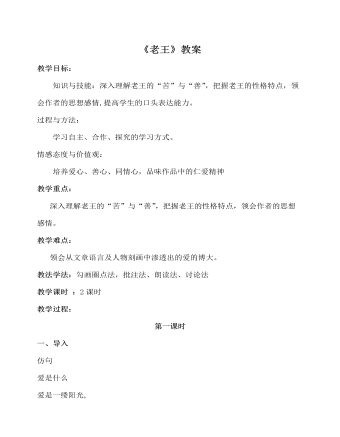
部编版语文七年级下册《老王》教案
阅读8-22自然段(第三部分)有一天,我在家听到打门,开门看见老王直僵僵地镶嵌在门框里。 “镶嵌”一词用得合适吗?为什么?合适。运用夸张的手法,强调了老王步履维艰,身体僵直的形态。指出这一段的外貌描写他面如死灰,两只眼上都结着一层翳,分不清哪一只瞎,哪一只不瞎。说得可笑些,他简直像棺材里倒出来的,就像我想像里的僵尸,骷髅上绷着一层枯黄的干皮,打上一棍就会散成一堆白骨。给加红色的字注音翳 yì眼角膜病变后留下的疤痕 骷髅 kūlóu注音释义往常他坐在蹬三轮的座上,或抱着冰伛着身子进我家来,不显得那么高。伛yǔ:弯(腰)曲(背)这几句外貌描写起什么作用?表现老王病重,烘托他的忠厚善良以及和对我家的深厚情意。比较下边每组两个句子,联系上下文,说说①在表达上的好处。
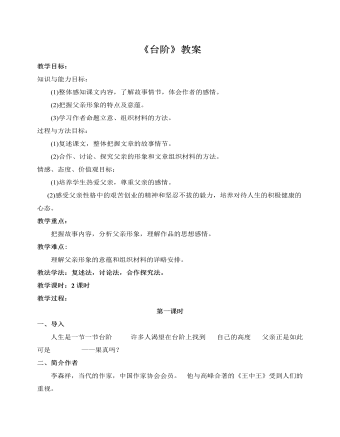
部编版语文七年级下册《台阶》教案
父亲是一个非常要强的农民,有志气,不甘人后,有长远的生活目标,有愚公移山的精神和坚韧不拔的毅力。老实厚道,诚实,不怕千辛万苦,有着中国传统农民所特有的谦卑。 作者写作本文的目的是什么?小说塑造了发展中的中国农村一个农民的典型形象。他的血管里有我们民族拼命硬干、坚忍不拔的精神,他身上所具备的优秀品质代表了新旧交替时期中国农民的突出特征。同时,这一形象还告诉我们,农民创业之所以如此艰难困苦,根源在于经济落后。亿万农民的希望在于先进的生产力,以此迅速改变农村落后面貌,结束老牛拉破车的日子。作者对父亲的优秀品质表示敬仰和赞叹;对父亲身上的中国传统农民所特有的谦卑表示同情;对改变农村的面貌寄予希望。 六、 语言理解1、 “父亲坐在绿阴里,能看见别人家高高的台阶,哪里栽着几棵柳树,柳树老是摇来晃去,却摇不散父亲那专注的目光。这时,一片片旱烟的烟雾在父亲头上飘来飘去。”这一处描写表现了父亲什么样的思想感情?为什么不用心理描写?
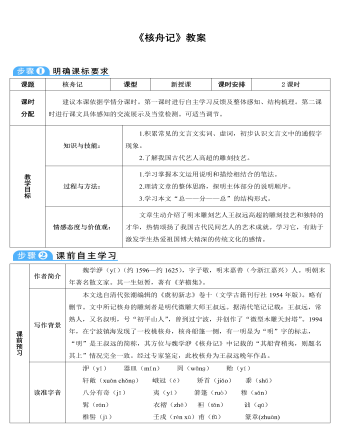
部编版语文八年级下册《核舟记》教案
1.课文第一段介绍雕刻品核舟的主题是“盖大苏泛赤壁云”,哪些地方说明是“泛舟”呢?至少有三个地方说明是“泛舟”。第一,从“苏、黄共阅一手卷”可知船行并不快;第二,从“舟尾横卧一楫”船桨放在甲板上,可知“泛舟”;第三,从“舟子”“居右者……若啸呼状。居左者……若听茶声然”可知“泛舟”。2.课文如此细致地介绍核舟这一雕刻品的艺术形象,说明了什么?说明雕刻家构思的巧妙,显示出古代工艺美术的卓越成就,赞美了我国古代劳动者的高超技艺。3.本文题目有“记”字,是否意味着是记叙文?它与《桃花源记》是不是一种文体?这是一篇介绍事物的说明文。题目中的“记”在这里是描述、摹写的意思。文章全面而真实地描述了雕刻在核舟上的人和物,活灵活现,使人能领会神奇的雕刻技巧。
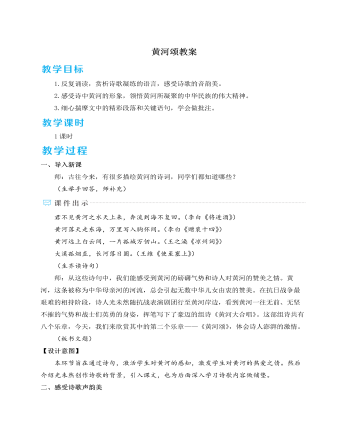
人教部编版七年级下册黄河颂教案
资料链接1.《黄河大合唱》《黄河大合唱》是由光未然作词、冼星海谱曲的一部大型合唱音乐作品,有《黄河船夫曲》《黄河颂》《黄河之水天上来》《黄水谣》《河边对口曲》《黄河怨》《保卫黄河》《怒吼吧,黄河!》八个乐章。诗中将雄奇的想象与现实的图景结合在一起,组成了一幅幅壮阔的历史画卷。2.中华民族精神中华民族在悠久的发展历史中,积淀和形成了自己独特而伟大的民族性格和民族精神。中华文化的基本精神,表现了自强不息、居安思危、厚德载物、乐天知足、崇尚礼仪等特征。中华文化的力量,集中体现为民族精神的力量。中华民族精神的核心是爱国主义。这种精神就像是泰山、长城一般壮丽地雄峙于世界的东方!疑难探究如何把握《黄河颂》语言上的特点?这首歌词写得明快雄健,节奏鲜明,音节洪亮。以短句为主,兼以长句;长短结合,自由奔放并且错落整齐。在韵脚上,隔二三句押韵,形成了自然和谐的韵律。
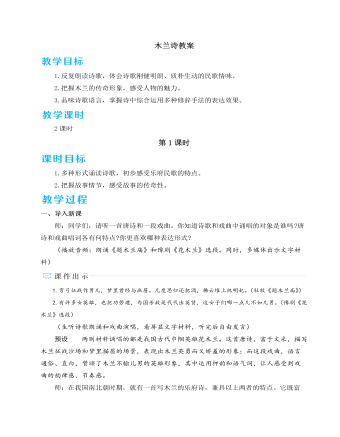
人教部编版七年级下册木兰诗教案
本教学设计着眼于民歌特点。第1课时重在诵读诗歌,设计不同层次的读,引导学生从诗歌的形式、节奏、韵律、情感四个方面感受民歌形式自由、具有韵律美、节奏感强、情感富于变化的特点,从而体会民歌的情味。第2课时重在品读诗歌,引导学生通过品析情节、品味语言、析读主题等方式,体会诗歌语言刚健明朗而质朴生动的特点,逐层解读民歌所塑造的传奇形象,并理解民歌所传达的爱国情怀。素养提升互 文互文,也叫互辞,是古诗文中常用的一种修辞手法。古文中对它的解释是:“参互成文,合而见义。”具体地说,它是这样一种表现形式:上下两句或一句话中的两个部分,看似各说两件事,实则是互相呼应,互相阐发,互相补充,说的是一件事。即上下文义互相交错、互相渗透、互相补充地来表达一个完整的意思。初中阶段,常见的互文一般有三类:(1)单句互文单句互文,即在同一个句子中前后两个词语在意义上相互交错、渗透、补充。如:秦时明月汉时关。

部编人教版四年级下册《猫》教案
三、总结全文,完成课后练习1.老舍笔下的猫你喜爱吗?为什么?老舍笔下的猫不像猫,倒像——(小孩子)。老舍把猫当作小孩子来写,用拟人化的手法写出了它的淘气、可爱,表达了对猫的喜爱之情。2.让我们有感情地朗读课文,把你的喜爱之情也表达出来。3.师述:你能学习课文的写法,围绕总起句写一段具体的话吗?【出示课件25】出示总起句(任选一题):(1)猫真老实。(2)猫很尽职。(3)课间活动丰富多彩。(4)这堂自习课真静啊!4.阅读链接【出示课件26】读读课后的阅读链接,体会不同作家对猫的喜爱之情。同样写猫,有什么不同?预设:夏丐尊写对猫的喜爱,用了衬托的方法,从妻子孩子对猫的喜爱,表达自身的喜爱之情。
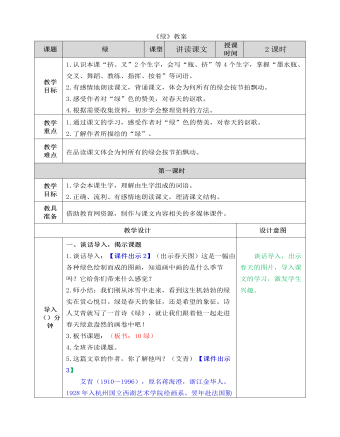
部编人教版四年级下册《绿》 教案
二、初读课文,整体感知1.自由地把课文朗读一遍。自学生字词语。2.检查生字词语:(1)读准字音。【出示课件4】墨水瓶、交叉、舞蹈、教练、指挥、按着节拍整齐集中墨绿嫩绿淡绿粉绿指名逐词读,指导学生读准字音。注意读准翘舌音“叉”,后鼻音“瓶”。(2)理解词义。学生分四人小组,交流一下不理解的词语。若是小组讨论无法解决的,提出来全班讨论。(3)重点指导:【出示课件5】交叉:方向不同的几条线或条状物互相穿过。节拍:是衡量节奏的单位,在音乐中,有一定强弱分别的一系列拍子在每隔一定时间重复出现。指挥:指导演奏的人。整齐:有秩序,协调一致。重叠:同样的东西层层堆叠,互相覆盖。(4)指导书写。大家读准了字音,了解了字义。请把要写的字在课堂本上每个字写一个,一定要看准每个字的笔画,端正、工整地把每一个字写好,注意写字的姿势。
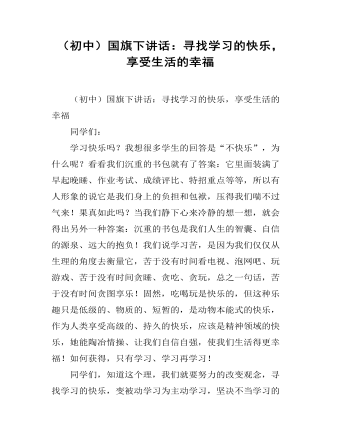
(初中)国旗下讲话:寻找学习的快乐,享受生活的幸福
学习快乐吗?我想很多学生的回答是“不快乐”,为什么呢?看看我们沉重的书包就有了答案:它里面装满了早起晚睡、作业考试、成绩评比、特招重点等等,所以有人形象的说它是我们身上的负担和包袱,压得我们喘不过气来!果真如此吗?当我们静下心来冷静的想一想,就会得出另外一种答案:沉重的书包是我们人生的智囊、自信的源泉、远大的抱负!我们说学习苦,是因为我们仅仅从生理的角度去衡量它,苦于没有时间看电视、泡网吧、玩游戏、苦于没有时间贪睡、贪吃、贪玩,总之一句话,苦于没有时间贪图享乐!固然,吃喝玩是快乐的,但这种乐趣只是低级的、物质的、短暂的,是动物本能式的快乐,作为人类享受高级的、持久的快乐,应该是精神领域的快乐,她能陶冶情操、让我们自信自强,使我们生活得更幸福!如何获得,只有学习、学习再学习!

人教版新目标初中英语七年级下册Where is the post office教案2篇
Period 2 (3a----Section B 2c)Preview(Pre-task): Key points: What laAdd another information about their pen pals----their language on the cardnguage does she/he speak?She/He speaks....Does she/he have any brothers and sisters? Does she/he speak English?Preview(Pre-task): Add another information about their pen pals----their language on the cardKey points: What language does she/he speak?She/He speaks....Does she/he have any brothers and sisters? Does she/he speak English?Step 1 Revision1.Revisionand dictation of the new words 2.Revise the drills they learned yesterday.(by pairwork and grammar exercise)Step 2 Leading-inT has a conversation with one student. The conversation is following:---Do you have a pen pal?---Yes, I do.---What's your pen pal's name? ---His/Her name is....---Where is your pen pal from? ---He/She is from...---Where does he/she live? ---He/She lives in....---What language does he/she speak?He/She speaks...Write the new words on the Bb. They are following: EnglishChineseJapaneseFrenchStep 3 LearnLearn the new words with the whole class.Finish 3a with the students3b Pairwork T still does an example with one student Then the Ss practise in pairs. The example is following:--Curry Muray is my pen pal. He is from the United States.---What language does he speak?

人教版新目标初中英语七年级下册I ’d like some noodles教案
教学过程Step 1: warming-up Sing a song---------“food and drink” Step 2: Revision1 Dictation2 Revise: What kind of noodles would you like?I’d like …What size bowl of noodles would you like?I’d like…Step 3: Presentation1 show pictures of food, ask students say the words.2 Students read the newspaper ad in 3a. Fill in blanks with words in the box. Then read the ad together, the teacher explains some difficult language points.3 Check the answers Step 4 PracticeAsk students to finish 3b in the same way according to 3a. Students read the short passage and fill in the blanks .At last, check the answers.Step 5 productionAsk students to write their own ad for dumplings, noodles, drinks, and other foods they know. Then ask students to read their partner’s ad. Then order food and drink from their partner.Step 6 Home workGroup work – make an ad about “food and drink”

人教版新目标初中英语七年级下册I want to be an actor教案2篇
三、教学建议第一课时:1. Lead in (Vocabulary)A) Before class, teacher should collect some pictures of working places. For example: Bank, TV Station, Restaurant, Police Station, Hospital ...B) In class, show students the pictures (PowerPoint, OHP). Ask students to tell the name of the working places and the name of the jobs.Shop assistant, doctor, actor, reporter, police office, waiter, bank clerk, studentC) Do exercise 1a and 3a.2. Bingo GameAsk groups of students to make up pairs of cards with a job on one and the related workplace on the other. For example, waiter / restaurant, teacher / school, doctor / hospital. Encourage students to use both the job / workplace combinations in the book and the ones that students came up during class discussions. Be sure they have twice as many sets of cards as there are students in the group. They can make two sets of cards for a single job / workplace, if necessary. Then have each group mix up its set of cards and hand their cards out in random order. Each time a student gets a pair of cards that match, he or she can lay these cards down. The goal is to have no cards in your hand at the end.3. Task OneA) Ask students to work in pairs and ask the partner what does he / she want to be in the future.e. g. :What do you / does he / does she want to be?I want to be a.Why?Because it's (adj).B) Vocabulary: Section B, 1a4. Homework 1.2.

人教版新目标初中英语七年级下册Where is your pen pal from教案
2.1Match the country with the language.Step II Reading3a? let the students read the letter fast and answer the questions.? Let the students ask more questions about the letter as possible as the can.Step III Writing3b.Step IV. Pairwork2cStep V Listening2a, 2bStep V. HomeworkExercises book(1) P3Exercises book (2) P3Period FourStep I . Dictate the words and sentences in Unit1.Step II. Self-checkStep III. Check the answers for Exercises book in the unit.Step IV. Home workRevise and preparation for unit 2.教学反思:通过本单元的学习,学生基本可以谈论人们的国籍,居住城市及其所说的语言,通过书信方式去介绍自己并寻找笔友。但在涉及到国外的一些城市时,学生对这方面的知识相对欠缺,能介绍的城市并不多,也反应出学生课前预习不充分,这跟学生学习条件也有关,大多数学生无法通过网络获取所需信息。因此,在以后的教学中要多指导学生通过计算机网络获取信息,拓宽知识面。

人教版新目标初中英语七年级下册Where did you go on vacation教案
句型: Where did you go on vacation? I went to summer camp.Did she go to Central Park?Yes,she did.No, she didn’t语法:一般过去时特殊疑问句、一般疑问句及肯、否定回答。课时安排4课时第一课时:Section A:la,1b,lc,2a,2b,2c 第二课时:Section A:3a,3b,4第三课时:Section B:1,2a,2b,2c第四课时:Section B:3a,3b,3c,4 and Self Check第一课时教学目标掌握描写假期生活的形容词。假期里自己所做事情的简单表达。谈论假期做的事情及当时情况。谈论假期时旅游的天气,旅游者以及食物等。教学过程一、导入播放一首英文歌曲:Let’s travel 说明:通过让学生听节奏欢快迪斯尼英语歌曲Let’s travel.引入本节课谈论的话题vacation and travel. 让歌曲使学生的思维活跃,增强课堂气氛,激发学生提高学习英语的兴趣。T:How is the trip ?Ss : It’s pretty good/ happy/exciting /relaxing/busy/dangerous/ fantastic说明:这个问题是为了操练形容词。建议让多个Ss作答。鼓励他们用不同的形容词。上述个别形容词本应在第二课时中出现,但可以在warming-up中第一次非正式出现。这些形容词也可在老师的评价语中适时出现,以加深学生对词汇的印象。

人教版新目标初中英语七年级下册Why do you like koalas教案2篇
单元整体说明(一)单元教材分析本单元的核心话题是描述动物和表达个人喜好,以及句式why do you like…? Because…。这也是本单元的教学重点。通过本单元的学习,学生应能较流利地运用所学词汇和句型描述动物,表达个人喜好。(二)单元知识结构1.词汇动物名称 tiger, elephant, koala, dolphin, etc.词汇描述性形容词: smart, cute, ugly, clever, shy, etc.国家名: Australia, South Africa2.句型Why do you like koala hears? Because they are cute.Where are pandas from? They're from China.What animals do you like? I like dolphins.(三)单元整体目标1.Master the vocabulary2.Master and use: Why do you like koalas? Because they am cute.Where are pandas from? They're from China.What animals do you like? I like dolphins.(四)单元教学重难点一览(五)单元学情分析学生此前已经学过由why, where, what 引导的特殊疑问句句型,具有了学习本单元知识的认知前提。形形色色的动物能激发学生的好奇心,产生了解它们的欲望,这有利于本单元知识的教学和学生学习兴趣的培养。

人教版新目标初中英语八年级下册He said I was hard-working教案2篇
This activity introduces some new vocabulary and provide oral practice using the target language.Task 1 . Ask four students to stand in front of the class, and the teacher asks them the following questions as a reporter.1.What are you going to do when you grow up?2.What are you going to do next week?3.What are going to do after school?The students will give different answers, then ask a good student to report what they said.I am going to e a doctor.What did she say?----------She said she was going to be a doctor.I am going to have a party on Friday night.What did he say?-------He said he was going to have a party on Friday night.I am going to do my homework.What did she say ?------ She said she was going to do her homework.I am going home after school.What did she say?-----She said she was going home after school.Say In this unit we are going to learn to use words like to report what someone said.Task 2. Read the instructions. Then ask a student to read the four questions. And write the words on the Bb. Explain what soap opera is.Task 3. Ask the students to Look at the pictures, point out the TV screens in the picture. Ask one girl to read what Marcia said.What did Marcia say? She said She said she was having a surprise party for Lana on Friday night. Repeat the other pictures in the same way.Activity3. Listen and number the pictures in activity 1a.

人教版新目标初中英语八年级下册How long have you been collecting shells教案2篇
Step Ⅱ Show the new words on the screen and teach the new words. Read the new words to students and ask them to repeat.Step Ⅲ 3aThis activity introduces new vocabulary and provides reading practice using the target language.In this activity first look at the four pictures.T: What can you see in the pictures?Ss: Four snow globes.T: Right. There are four snow globes in the pictures. And what are they?Ss: They are a monster, two polar bears, two penguins and a birthday cake.Write these words on the blackboard: snow globe; monster; polar bear; penguin and birthday cake. Read them to the class and ask students to repeat each one. Make sure students understand each word.Use a computer to show the E-mail message on the screen and read the message to students.Get students to read the e-mail on their own, and then draw lines connecting each snow globe and its description.Correct the answers.AnswersA line should connect each snow globe picture with the words that describe it in the letter.Step Ⅳ 3bThis activity provides writing practice using the target language.First review Activity 2a on Page 47.Then ask students to complete the message according to Activity 2a.Some partial sentences are given to students. Write about one person's collection.When students work, walk around the room checking the progress and offering help as needed.When they finish, ask some students to read their messages to the class.

人教版新目标初中英语八年级下册Would you mind turning down the music教案
Step 4. Group work (4)1. Ask a pair of students to read the dialogue. Say, This activity provides speaking, listening and writing practice using the target language.2. Ask students to complete the work in groups.3. Check the answers with the whole class. 4. Explain some of the language points. Step 5. Word review (Self check 1)1. Ask students to read the words and the phrases given. 2. Fill in the blanks with proper forms of these words to complete the sentences. 3. Check the answers with the whole class. Homework:Do activity 2 on page 57 after class. Period 6Teaching aims: 1. Teach vocabulary words and the useful expressions. 2. Enable the students to learn etiquette in different culture. 3. Help the students learn how to behave politely in public places and in daily life. Teaching procedures:Step 1. RevisionHelp students to review the function of making requests through a free talk. Then lead them to the topic of etiquette. Explain the meaning of etiquette. Or, ask students to look it up in the dictionary. Step 2. Pre-reading (Section 1)1. Ask students to read the picture and make a list with their partner about how many rules of etiquette can be seen being broken.

人教版新目标初中英语七年级下册How was your weekend教案2篇
Teaching Goal:1. General aims:Talk about recent past events2. Particular aims:A. Language Focus.Talk about recent past events and think of the past events.B. Language goalsHow was….?It was …What did …do over the weekend?C. Language structures:(1). How was your weekend? I was great. Pay attention to no form.(2). What did you do over the weekend? I played soccer. We went to the beach.D. Useful words and phrases:Words: was, did, went, beach, over, project, test, wasn’t, false, number, geography, spend, week, most, mixture, their, had, little, cook, read, saw, change, everyone, sit, sat, no, anythingPhrases: did one’s homework, played soccer, cleaned my room, went to the beach, played tennis, went to the movies, on Saturday morning, over the weekend, cook … for, what about, do some reading, have a party, talk show, go shoppingE. Grammar language:Present simple past tenseRegular and irregular verbsF. Learning strategies:Tour and holidaysG. Interdiscipinary:H. Emotion and manner:Teaching time: 5 periodsTeaching procedures:Period One教学步骤、时间 教师活动 学生活动 媒体应用Step 1Free talk 3’ Ask some questions like:Who’s on duty today?What’s the weather like? Answer and talk about something.让同学们回答下列问题1. Do you like weekend? (Let some students answer)It takes them three minutes to talk about the question.2. Why do you like weekend? (let the students answer) Most of the students like the weekend此时教师用汉语问:“在周末期间问你干了什么?这句话用英语这么回答?Let the students guess.At last the teacher give them right answer3. What did you do over the weekend?(板书、学习)

